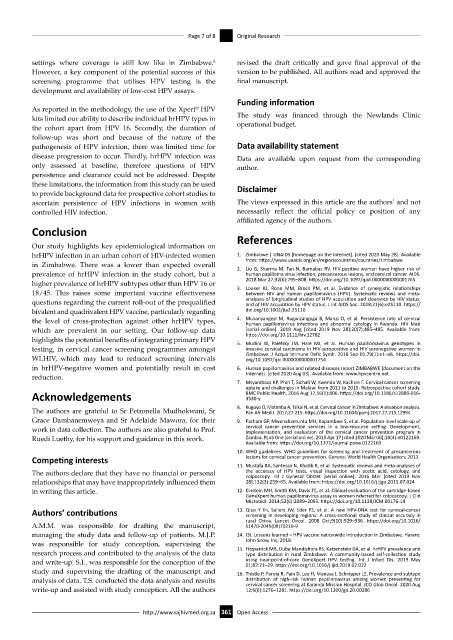Page 369 - HIVMED_v21_i1.indb
P. 369
Page 7 of 8 Original Research
8
settings where coverage is still low like in Zimbabwe. revised the draft critically and gave final approval of the
However, a key component of the potential success of this version to be published. All authors read and approved the
screening programme that utilises HPV testing is the final manuscript.
development and availability of low-cost HPV assays.
Funding information
As reported in the methodology, the use of the Xpert HPV
®
kits limited our ability to describe individual hrHPV types in The study was financed through the Newlands Clinic
the cohort apart from HPV 16. Secondly, the duration of operational budget.
follow-up was short and because of the nature of the
pathogenesis of HPV infection, there was limited time for Data availability statement
disease progression to occur. Thirdly, hrHPV infection was Data are available upon request from the corresponding
only assessed at baseline, therefore questions of HPV author.
persistence and clearance could not be addressed. Despite
these limitations, the information from this study can be used Disclaimer
to provide background data for prospective cohort studies to
ascertain persistence of HPV infections in women with The views expressed in this article are the authors’ and not
controlled HIV infection. necessarily reflect the official policy or position of any
affiliated agency of the authors.
Conclusion
Our study highlights key epidemiological information on References
hrHPV infection in an urban cohort of HIV-infected women 1. Zimbabwe | UNAIDS [homepage on the Internet]. [cited 2020 May 28]. Available
from: https://www.unaids.org/en/regionscountries/countries/zimbabwe
in Zimbabwe. There was a lower than expected overall 2. Liu G, Sharma M, Tan N, Barnabas RV. HIV-positive women have higher risk of
prevalence of hrHPV infection in the study cohort, but a human papilloma virus infection, precancerous lesions, and cervical cancer. AIDS.
higher prevalence of hrHPV subtypes other than HPV 16 or 2018 Mar 27;32(6):795–808. https://doi.org/10.1097/qad.0000000000001765
18/45. This raises some important vaccine effectiveness 3. Looker KJ, Rönn MM, Brock PM, et al. Evidence of synergistic relationships
between HIV and human papillomavirus (HPV): Systematic reviews and meta-
questions regarding the current roll-out of the prequalified analyses of longitudinal studies of HPV acquisition and clearance by HIV status,
and of HIV acquisition by HPV status. J Int AIDS Soc. 2018;21(6):e25110. https://
bivalent and quadrivalent HPV vaccine, particularly regarding doi.org/10.1002/jia2.25110
the level of cross-protection against other hrHPV types, 4. Mukanyangezi M, Rugwizangoga B, Manzi O, et al. Persistence rate of cervical
human papillomavirus infections and abnormal cytology in Rwanda. HIV Med
which are prevalent in our setting. Our follow-up data [serial online]. 2019 Aug [cited 2019 Nov 28];20(7):485–495. Available from:
https://doi.org/10.1111/hiv.12782
highlights the potential benefits of integrating primary HPV 5. Mudini W, Palefsky JM, Hale MJ, et al. Human papillomavirus genotypes in
testing, in cervical cancer screening programmes amongst invasive cervical carcinoma in HIV-seropositive and HIV-seronegative women in
WLHIV, which may lead to reduced screening intervals Zimbabwe. J Acquir Immune Defic Syndr. 2018 Sep 01;79(1):e1–e6. https://doi.
org/10.1097/qai.0000000000001754
in hrHPV-negative women and potentially result in cost 6. Human papillomavirus and related diseases report ZIMBABWE [document on the
reduction. Internet]. [cited 2020 Aug 03]. Available from: www.hpvcentre.net
7. Msyamboza KP, Phiri T, Sichali W, Kwenda W, Kachale F. Cervical cancer screening
uptake and challenges in Malawi from 2011 to 2015: Retrospective cohort study.
Acknowledgements BMC Public Health. 2016 Aug 17;16(1):806. https://doi.org/10.1186/s12889-016-
3530-y
8. Kuguyo O, Matimba A, Tsikai N, et al. Cervical cancer in Zimbabwe: A situation analysis.
The authors are grateful to Sr Petronella Mudhokwani, Sr Pan Afr Med J. 2017;27:215. https://doi.org/10.11604/pamj.2017. 27. 215.12994
Grace Dambanemweya and Sr Adelaide Mawora, for their 9. Parham GP, Mwanahamuntu MH, Kapambwe S, et al. Population-level scale-up of
work in data collection. The authors are also grateful to Prof. cervical cancer prevention services in a low-resource setting: Development,
implementation, and evaluation of the cervical cancer prevention program in
Ruedi Luethy, for his support and guidance in this work. Zambia. PLoS One [serial online]. 2015 Apr 17 [cited 2020 Mar 06];10(4):e0122169.
Available from: https://doi.org/10.1371/journal.pone.0122169
10. WHO guidelines. WHO guidelines for screening and treatment of precancerous
Competing interests lesions for cervical cancer prevention. Geneva: World Health Organisation; 2013.
11. Mustafa RA, Santesso N, Khatib R, et al. Systematic reviews and meta-analyses of
The authors declare that they have no financial or personal the accuracy of HPV tests, visual inspection with acetic acid, cytology, and
colposcopy. Int J Gynecol Obstet [serial online]. 2016 Mar [cited 2019 Nov
relationships that may have inappropriately influenced them 28];132(3):259–65. Available from: https://doi.org/10.1016/j.ijgo.2015.07.024
in writing this article. 12. Einstein MH, Smith KM, Davis TE, et al. Clinical evaluation of the cartridge-based
GeneXpert human papillomavirus assay in women referred for colposcopy. J Clin
Microbiol. 2014;52(6):2089–2095. https://doi.org/10.1128/JCM.00176-14
Authors’ contributions 13. Qiao Y lin, Sellors JW, Eder PS, et al. A new HPV-DNA test for cervical-cancer
screening in developing regions: A cross-sectional study of clinical accuracy in
rural China. Lancet Oncol. 2008 Oct;9(10):929–936. https://doi.org/10.1016/
A.M.M. was responsible for drafting the manuscript, S1470-2045(08)70210-9
managing the study data and follow-up of patients. M.J.P. 14. JSI. Lessons learned – HPV vaccine nationwide introduction in Zimbabwe. Harare:
was responsible for study conception, supervising the John Snow, Inc; 2018.
research process and contributed to the analysis of the data 15. Fitzpatrick MB, Dube Mandishora RS, Katzenstein DA, et al. hrHPV prevalence and
type distribution in rural Zimbabwe: A community-based self-collection study
and write-up. S.L. was responsible for the conception of the using near-point-of-care GeneXpert HPV testing. Int J Infect Dis. 2019 May
01;82:21–29. https://doi.org/10.1016/j.ijid.2019.02.022
study and supervising the drafting of the manuscript and 16. Thistle P, Parpia R, Pain D, Lee H, Manasa J, Schnipper LE. Prevalence and subtype
analysis of data. T.S. conducted the data analysis and results distribution of high-risk human papillomavirus among women presenting for
cervical cancer screening at Karanda Mission Hospital. JCO Glob Oncol. 2020 Aug
write-up and assisted with study conception. All the authors 12;6(6):1276–1281. https://doi.org/10.1200/go.20.00286
http://www.sajhivmed.org.za 361 Open Access

